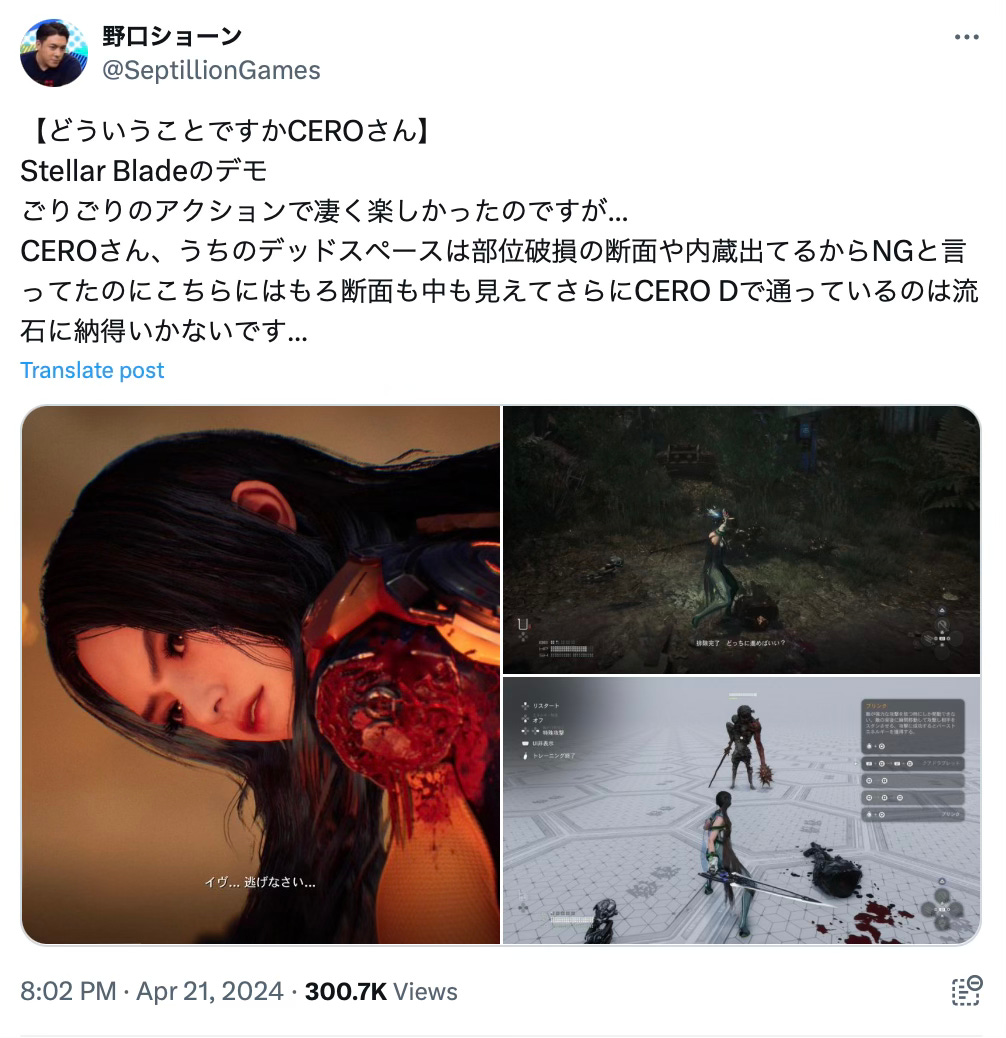Japan's CERO Age Rating System and Why Resident Evil is Censored in Japan
Earlier this month (April 2024), EA’s Japan General Manager, Shaun Noguchi, made headlines when he made the following tweet:
“What’s going on, CERO?
The Stellar Blade demo goes hard on the action and is quite entertaining… but why did CERO refuse to issue an age rating for Dead Space due to its depictions of bodily damage, dismemberment and internal organs, while Stellar Blade, which portrays the same things, is issued a CERO D rating, to boot?! I don’t get it…
For a little background, EA’s Dead Space, a survival horror game like Resident Evil, was released back in January 2023. A remake of the 2008 title of the same name, Dead Space was released to critical acclaim and was largely considered a fresh start and a return to form for the IP. However, it was never released in Japan because EA could not obtain clearance from Japan’s Computer Entertainment Ratings Organization (known as CERO), which issues age ratings for games in Japan, just as the ESRB, PEGI, USK, GRAC, and other similar organizations do in other countries.
Interestingly enough, another survival horror game, Callisto Protocol, encountered the same issue just months earlier; like Dead Space, Callisto Protocol ultimately skipped over Japan due to publisher Krafton’s inability to secure a CERO rating.
EA or Krafton may have been wise to seek Capcom’s advice on the CERO matter. Like Dead Space and Callisto Protocol, Capcom’s Resident Evil series depicts violence and gore that inevitably invite scrutiny from Japan’s ratings board. CERO’s requirements are so rigid that, since 2017, Capcom has been required to develop special variants of each RE game that tone down depictions of violence, resulting in as many as three separate variants of a single RE game; two for Japan, and one for the rest of the world. I’ll go into more detail about these variations below.
A General Overview of CERO
CERO functions much like the ESRB (Entertainment Software Ratings Board) does in North America or PEGI (Pan-European Game Information) in the UK: it evaluates games and assigns them a rating based on their content. By receiving a CERO rating, the publisher will be allowed to distribute the game, especially in physical format, in Japanese retail stores.
In issuing a rating, CERO examines a game’s visual depictions, use of language (including game text) and overall theme to decide whether it should be rated A, B, C, D, or Z. Here is a graph conveniently prepared by CERO itself explaining the age demographic each letter corresponds to:
The two primary ratings that concern the RE series are D and Z. Curiously, the two ratings are only separated by a year, with D including 17-year olds and Z excluding them. A few older RE games have gotten the milder CERO C rating (like the Chronicles titles), but typically the series gets a D and/or Z.
A game acquiring a Z rating can have implications on a game’s marketability, for better or worse. For games that target mature audiences (games that would have earned an ESRB M or a PEGI 18 in other countries), a CERO Z could mean minimal promotion at Japanese retail stores or outright refusal to carry the title.
In April 2023, a major Japanese retailer, Nojima, stopped carrying CERO Z titles in its stores. Explaining its rationale, Nojima stated, “We want to foster a safer and more relaxed environment for each and every one of our customers to shop in.” That’s likely PR speak for Nojima’s customers being primarily younger (sub-18 year old ) audiences and their parents, thus making it unprofitable for Nojima to sell CERO Z titles.
The CERO Z rating has other implications. Websites or streams for CERO Z-rated game require age verification to access.
Biohazard D vs. Biohazard Z
From 2017 until 2022, Capcom released two variants of each major Resident Evil (Biohazard) in Japan, which include:
BIOHAZARD 7 resident evil (Resident Evil 7 BIOHAZARD)
BIOHAZARD RE:2 (Resident Evil 2)
BIOHAZARD RE:3 (Resident Evil 3)
BIOHAZARD VILLAGE (Resident Evil Village)
These four titles saw dual releases, one with a CERO D rating and another with a CERO Z.
The companion titles BIOHAZARD RESISTANCE and BIOHAZARD RE:VERSE only saw single releases with a CERO D rating.
RE7: Grotesque vs Less-Grotesque
The first time Capcom was compelled to release two CERO variants of a single RE title was with RE7 in January 2017. To distinguish between the two variants, Capcom added a subtitle to the Z version, resulting in BIOHAZARD 7 resident evil Grotesque ver. for the CERO Z edition.
As the subtitle suggests, the CERO Z version depicts a more grotesque level of gore compared to the “mild” (in Capcom’s own words) CERO D version. Bodily mutilation and blood splatter has been reduced or taken out entirely from cutscenes in the CERO D version.
Here’s an image of one of the differences between Grotesque and Less-Grotesque:
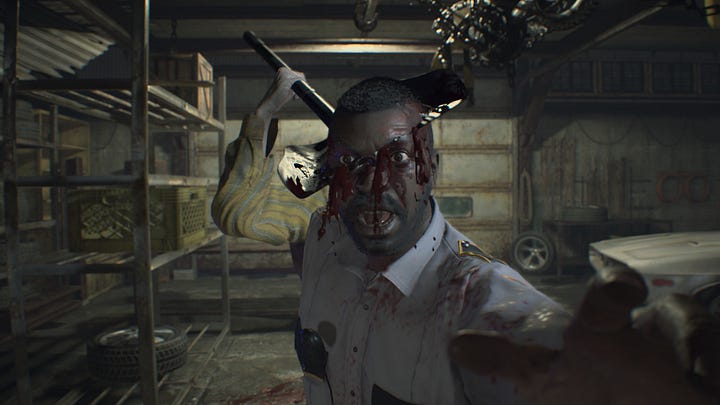

You’ll see from the gallery that in the Grotesque Ver., the shovel goes through poor Officer Anderson’s head, while it… simply doesn’t in the CERO D version.
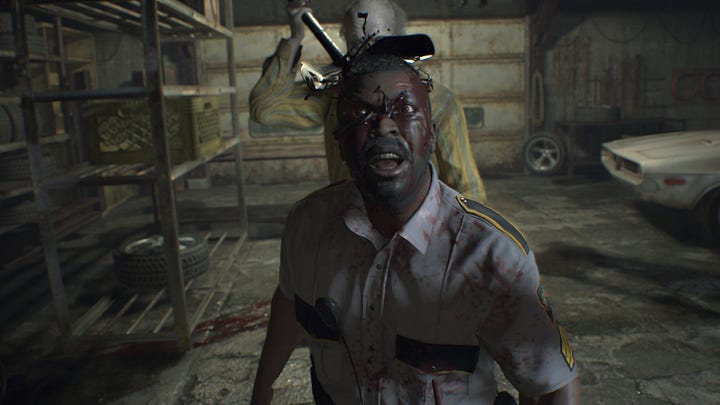
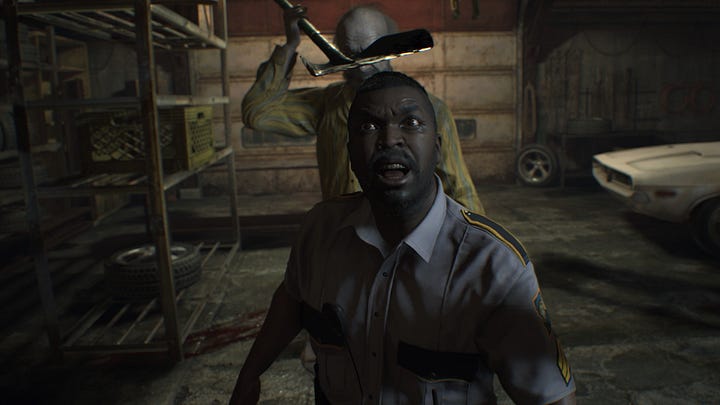
You’ll then see as Jack pulls back the shovel, the Grotesque Ver. shows blood and gore, while the D version doesn’t. The D version is extremely mild in this regard; there’s no blood on the clothing, for example.
In December 2022, RE7 was re-released for the Nintendo Switch as a cloud title, with the CERO Z version renamed to BIOHAZARD 7 resident evil Z Ver., greatly simplifying the name and bringing the branding in line with later titles in the series.
Notably, the Grotesque and Less-Grotesque variants of RE7 are treated as separate games in terms of save data and Achievements/Trophies. Save data is not compatible between the two variants on any platform, and Achievement/Trophy hunters can earn a second Platinum on PlayStation or otherwise increase their Gamerscore on Xbox.
RE2: D vs. Z
Next, we have the 2019 remake of RE2, the second game in the series to get two variants in Japan: BIOHAZARD RE:2 Z Version and BIOHAZARD RE:2 (which has a CERO D). Like RE7, the violence levels have been reduced in the CERO D version compared to CERO Z, but the changes are more minor overall. The D version has no dismemberment whatsoever, while the Z version has some dismemberment, which all turn black to mask the gore.
RE3: D vs. Z
Like its predecessor, the 2020 RE3 remake also saw two variants, CERO D and CERO Z. As with RE2, the violence depictions are similar between the two, with the exception of CERO Z featuring more dismemberment.
Village: D vs. Z
Same story here as the other three titles; D is milder than Z, especially with regards to mutilation and dismemberment.
The most prominent difference between CERO D and CERO Z is when an enemy ninja-slashes Ethan’s right hand; it remains intact in the CERO D and Z releases, while it’s severed in the Overseas release.
RE4: Z only
BIOHAZARD RE:4, the 2023 remake of Resident Evil 4, is the first major RE game in years to see only a single variant, with the game only being issued a CERO Z rating.
While Capcom did not publicly disclose why they decided to release only a CERO Z version, sales data from Media Create offer valuable insight into Capcom’s reasoning. Of the four RE titles that saw two physical variants at Japanese retail, the CERO Z version far outsold its CERO D counterpart.
CERO D vs. CERO Z vs. Overseas (Not-Japan) Releases
The situation of violent depictions in the recent RE games is further complicated by the fact both Japanese variants are themselves different from what the versions of each game released outside Japan depict. Even though CERO Z releases in Japan are, in a local context, supposed to be uncensored, the CERO Z versions are actually even less violent the overseas releases. For example, let’s look back at Deputy David Anderson from RE7:
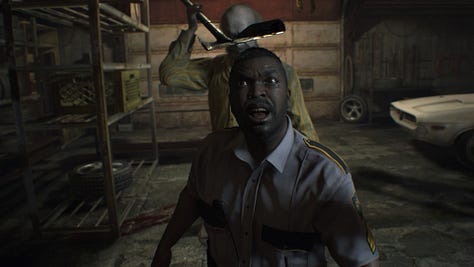
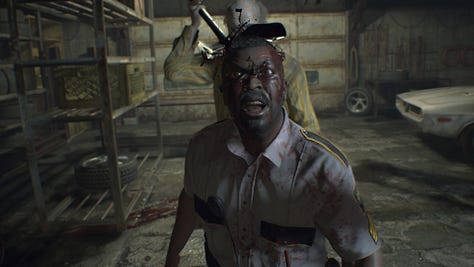

As you can see, Anderson’s head is quite literally sliced in half in real time, while it simply isn’t in the CERO Z release. Why is this the case?
Here’s an example from RE2:
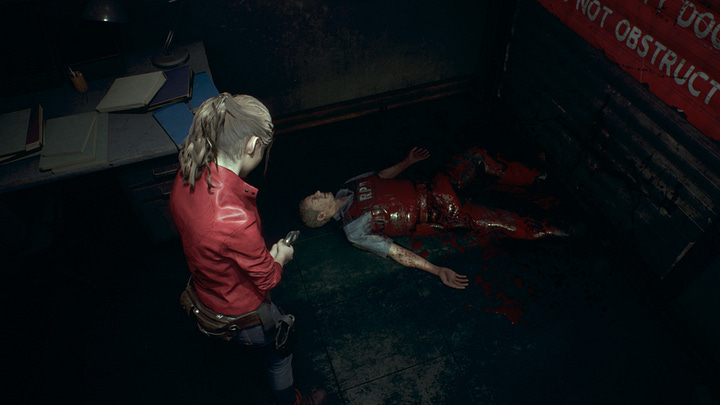
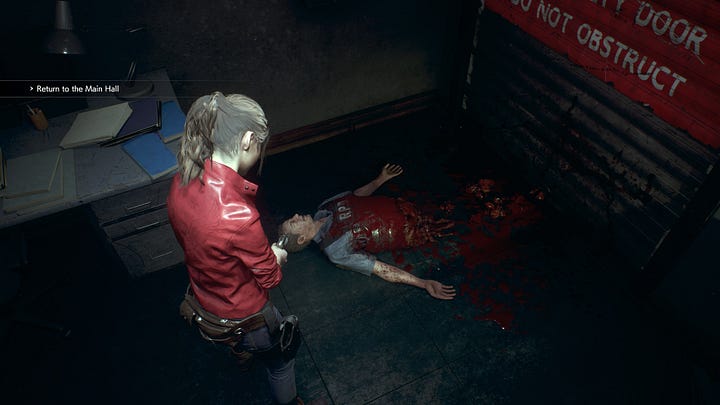
You can see that in both the CERO D and CERO Z releases, Elliott’s body remains intact, while it’s been severed in half in the Overseas Version.
Let’s go back to CERO’s public guidelines, which can be found in their Code of Ethics section. The following depictions of violence are classified as “Banned Expressions” under CERO rules:
-- Violence expressions --
1. Expression of animated blood that gives an extremely cruel impression.
2. Expression of mutilation/body-cutting that gives an extremely cruel impression.
3. Expression of a corpse that gives an extremely cruel impression.
4. Expression of killing/wounding that gives an extremely cruel impression.
5. Expression of horror that gives an extremely cruel impression.
Essentially, a depiction of violence must be deemed to convey “an extremely cruel impression” to be considered a banned expression, which would disqualify it from receiving a CERO rating, thus preventing it from seeing an official release in the Japanese market. Clearly, the Anderson and Elliott examples were too much for CERO’s guidelines.
Debating the Logic of CERO Censorship
Opinions will vary from person to person, but I do personally believe that violence and gore in RE7 and the rest of the recent RE games could be considered “extremely cruel.” Getting half of one’s head chopped off with a shovel is certainly no ordinary depiction in a video game, even a mature one. As much as I love the RE series for its mature content, I actually have a lower tolerance of blood and gore than one might assume, and during extremely grotesque scenes in movies or games, I tend to just close my eyes. (The Walking Dead Season 7, Episode 1, I’m looking at you. No pun intended.)
Whether extreme cruelty should be grounds for essentially banning a game from commercial release in a major market like Japan is a different question altogether. My personal stance is that because CERO Z is explicitly for 18-year olds and older, the current age of majority in Japan, there should be no restrictions in selling uncensored video game content to adults.
However, the issue of Japan’s age of majority is not a clear cut (no pun intended here, either) situation. In actuality, the age of majority in Japan was 20 until April 1, 2022, when it was revised down to 18. This meant that until 2022, eligibility for purchasing CERO Z games included 18 and 19-year old “minors.” In this context, perhaps restricting extremely cruel depictions made some sense, but nowadays, it seems like an outdated restriction.
Which brings us back to Shaun Noguchi’s criticisms of CERO for approving Stellar Blade without requiring concessions compared to the overseas version while not approving Dead Space. I find myself largely agreeing with Noguchi; I haven’t played Stellar Blade, but it does make me wonder how it could have gotten a CERO D rating. The only reason I can think of is Stellar Blade perhaps being far more fantasy-driven than RE, Dead Space or Callisto Protocol, which are hyper-realistic survival horror titles. Perhaps this is why CERO doesn’t consider Stellar Blade to leave “an extremely cruel impression.”
At the same time, I do have to wonder if EA and Krafton should have tried going the Capcom route with censored versions specifically for the Japanese market. It would have required weeks of crucial development resources being dedicated to a release in one region that historically isn’t even a large one for horror IP (everything horror that isn’t RE tends to do OK-to-middling in Japan, regardless of where it’s made).
Circumventing CERO Restrictions
In this day and age, Japanese consumers have options when a game does not come out in their region, or is only released with censored depictions. The most obvious one is to import the game from another territory. All of Nintendo, Sony, and Microsoft’s current consoles are region-free, while Dead Space, Callisto Protocol, and almost all RE games from the past 15 years allow players to select the Japanese localizations, should they choose to do so.
Even Amazon Japan sells import games these days, and it’s notable that overseas versions of Dead Space, Callisto Protocol and the recent RE titles actually charted on the Amazon Japan’s Top 100 Ranking around the time of each game’s respective global launch. Import shops in Tokyo’s Akihabara district pick up the slack for those who choose to purchase in-person.
It will be interesting to see if CERO’s regulations evolve in the future to address more high-profile cases like what we saw with Dead Space and Callisto Protocol.


